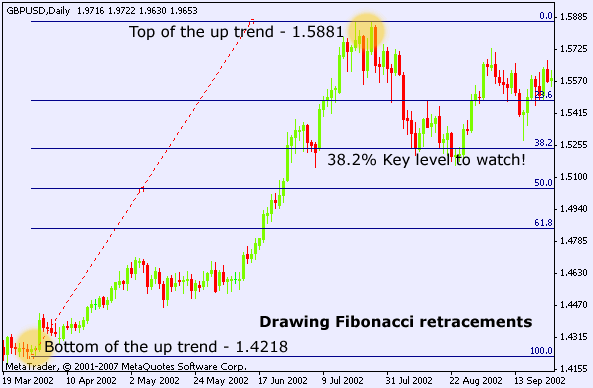Fibonacci Trading
Post on: 7 Август, 2015 No Comment

Day Trading Using Multiple Fibonacci Levels
You’ve probably heard of Fibonacci Trading using common retracement levels such as 38.3%, 50% and 61.8%, but what I’m going to show you here is a method of day trading using a confluence of two retracement levels measured from two different price lows. This combination of levels drawn from two separate price lows can form very strong support and resistance areas when they happen to be close together.
For those new to Fibonacci retracements levels, these Fib levels are derived from the Fibonacci sequence numbers 1,2,3,5,8,13,21,34,55,89,144. etc. that you learned way back in high school math class.
Remember? You just add the first two numbers together to get the next number in the sequence. 1 + 2 = 3, then you add the next two numbers. 2 + 3 = 5, 3 + 5 = 8. and so on.
Carry that on for a while and then take any number in the sequence and divide by it’s neighbor on the right and you have the Golden Ratio .618 or 61.8%.
Take any number in the sequence and divide by two numbers to its right and you get another important retracement level .382 or 38.2%. You might find it interesting that .382 + .618 = 1. I don’t have the retracement level 50% on this image to the right, but 50% is actually a common retracement level used in trading, but not derived from Fib numbers.
If you’ve never heard of the Golden Ratio (aka Phi, Golden Mean, Golden Section, Divine Proportion, Golden Number), and have any sense of curiosity at all, you owe it to yourself to read about this incredible, and astonishing irrational number. The Golden Ratio is found in so many different areas of nature, that there are entire books and websites devoted to it. The ratio is even found throughout your entire body and face. In fact, it’s now known that a person’s physical attractiveness is mostly determined by how closely their measurements adhere to this Fibonacci ratio.
Day Trading Using Confluent Fibonacci Levels
There’s two different ways to use this Fibonacci trading method. You can start by looking for stocks with an established up-trend on a 60 minute chart or look for stocks that are breaking a trendline and starting a new up trend.
For our example we’ll use Humana (HUM). HUM has broken a downward trendline and is starting a new upward trend on its 60 minute chart below.
Notice the increasing volume on the break of the trendline. That’s a good indication that the trend may continue up. You can see that HUM at the end of the August 10th session is making a retracement. That is what we’re looking for — a pullback after the break of a trendline.
Now, looking at the last several days of that same chart (below), a Fibonacci retracement tool is used to place the levels from the lowest low to the high.
Next, on the same 60 minute chart (below), the Fib levels (yellow) are drawn from the next higher low to the same high. I also placed a new trendline on the chart as well.
Notice how price has retraced at the end of this trading session, down to a confluence of the 50% level and 61.8% level of the two separately drawn Fib lines. An added level of support to this area is the confluence of the new upward trendline.
So, what can you do with this confluence of support from three separate sources? You can set up a trigger for a low risk trade.
How could this have played out the next morning for an alert trader with HUM on their radar? If the trader felt that support area was the possible low before the next thrust up on the 60 minute chart, she could be ready to buy from a number of different entry strategies such as the trendline break below.
Interestingly, no less than five — 10 minute candles tested the bottom of this support area, before price continued its advance.
Fibonacci trading levels can be useful in day trading, but don’t use them in a vacuum.
If you use Fib tools, always use them as a complement to other forms of technical analysis, such as price action patterns, trendlines, etc, and always look to use them within the context of a low risk — high reward potential trade.














